
Nepenthes is a genus of carnivorous plants, also known as tropical pitcher plants, or monkey cups, in the monotypic family Nepenthaceae. The genus includes about 170 species, and numerous natural and many cultivated hybrids. They are mostly liana-forming plants of the Old World tropics, ranging from South China, Indonesia, Malaysia, and the Philippines; westward to Madagascar and the Seychelles (one); southward to Australia (four) and New Caledonia (one); and northward to India (one) and Sri Lanka (one). The greatest diversity occurs on Borneo, Sumatra, and the Philippines, with many endemic species. Many are plants of hot, humid, lowland areas, but the majority are tropical montane plants, receiving warm days but cool to cold, humid nights year round. A few are considered tropical alpine, with cool days and nights near freezing. The name "monkey cups" refers to the fact that monkeys were once thought to drink rainwater from the pitchers.
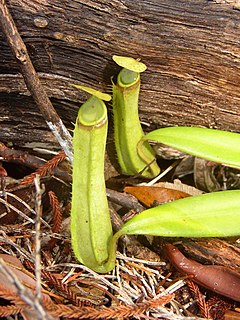
Nepenthes albomarginata is a tropical pitcher plant native to Borneo, Peninsular Malaysia, and Sumatra.
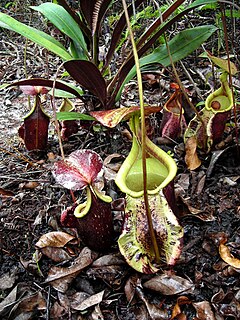
Nepenthes rafflesiana, or Raffles' pitcher-plant, is a species of tropical pitcher plant. It has a very wide distribution covering Borneo, Sumatra, Peninsular Malaysia, and Singapore. Nepenthes rafflesiana is extremely variable, with numerous forms and varieties described. In Borneo alone, there are at least three distinct varieties. The giant form of this species produces enormous pitchers rivalling those of N. rajah in size.

Nepenthes ampullaria is a very distinctive and widespread species of tropical pitcher plant, present in Borneo, the Maluku Islands, New Guinea, Peninsular Malaysia, Singapore, Sumatra, and Thailand.

Nepenthes gracilis, or the slender pitcher-plant, is a common lowland pitcher plant that is widespread in the Sunda region. It has been recorded from Borneo, Cambodia, Peninsular Malaysia, Singapore, Sulawesi, Sumatra, and Thailand. The species has a wide altitudinal distribution of 0 to 1100 m above sea level, although most populations are found below 100 m and plants are rare above 1000 m. Despite being a widespread plant, natural hybrids between N. gracilis and other species are quite rare.

Nepenthes bicalcarata, also known as the fanged pitcher-plant, is a tropical pitcher plant endemic to northwestern Borneo, Indonesia. It is a myrmecophyte noted for its mutualistic association with a species of ant, Camponotus schmitzi. As an ant-fed plant it lacks many of the features that characterise the carnivorous syndrome in Nepenthes, including viscoelastic and highly acidic pitcher fluid, the waxy zone of the pitcher interior, and possibly even functional digestive enzymes.

Nepenthes fusca, or the dusky pitcher-plant, is a tropical pitcher plant endemic to Borneo. It is found throughout a wide altitudinal range and is almost always epiphytic in nature, primarily growing in mossy forest.

Nepenthes clipeata, or the shield-leaved pitcher-plant, is a tropical pitcher plant known only from the near-vertical granite cliff faces of Mount Kelam in west kalimantan, Indonesia. It has an altitudinal distribution between approximately 600 and 800 m.

Nepenthes ephippiata, or the saddle-leaved pitcher-plant, is a tropical pitcher plant endemic to Borneo. It occurs in the Hose Mountains of central Sarawak, as well as Mount Raya and Bukit Lesung in Kalimantan. Non-climbing plants from the Hose Mountains appear to have less decurrent leaf attachment than specimens from Central Kalimantan, however the characteristic saddle after which the species is named is fully developed in climbing plants. Nepenthes ephippiata is closely related to N. lowii.
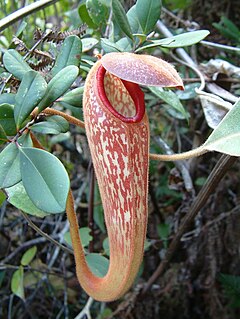
Nepenthes klossii is a tropical pitcher plant endemic to New Guinea.

Nepenthes mollis, or the velvet pitcher-plant, is a tropical pitcher plant species natives to Kalimantan, Borneo. It used to be known only from a single dried herbarium specimen and is the sole recognised species in the genus Nepenthes of which the pitchers are unknown. In 2019 Global Wildlife Conservation announced the rediscovery of the species.

Nepenthes campanulata, the bell-shaped pitcher-plant, is a tropical pitcher plant native to Borneo. It has also been reported from Palawan, the Philippines, though further field work is needed to confirm this identification.

Nepenthes faizaliana is a tropical pitcher plant endemic to the limestone cliffs of Gunung Mulu National Park in Sarawak, Borneo. It is thought to be most closely related to N. boschiana.

Nepenthes vogelii is a tropical pitcher plant endemic to Borneo. It is thought to be most closely related to N. fusca.

Nepenthes eymae is a tropical pitcher plant endemic to Sulawesi in Indonesia, where it grows at elevations of 1,000–2,000 m (3,300–6,600 ft) above sea level. It is very closely related to N. maxima, from which it differs in its wine glass-shaped upper pitchers.
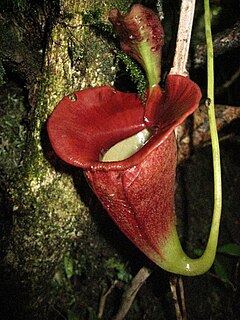
Nepenthes jacquelineae is a tropical pitcher plant endemic to the Indonesian island of Sumatra. Due to its unique pitcher morphology, it is considered to be one of the most spectacular Nepenthes species native to the island.

Nepenthes rhombicaulis is a tropical pitcher plant endemic to Sumatra. The specific epithet rhombicaulis is formed from the Latin words rhombicus, meaning "rhomboid", and caulis, "stem". It refers to the cross-sectional shape of the stem internodes.
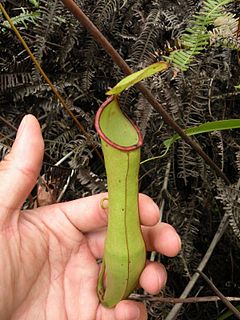
Nepenthes × sharifah-hapsahii is a natural hybrid between N. gracilis and N. mirabilis. It has been recorded from Borneo, Peninsular Malaysia, Sumatra, and Thailand, although it was originally described as a species endemic to Peninsular Malaysia, where it was said to grow at elevations below 1000 m.

Nepenthes hemsleyana is a tropical pitcher plant endemic to Borneo, where it grows in peat swamp forest and heath forest below 200 m above sea level.
Nepenthes fractiflexa is a tropical pitcher plant endemic to Borneo, where it has been recorded from a small number of localities across Sarawak and Kalimantan. It grows both terrestrially and epiphytically in ridge forest at elevations of 1400–2150 m above sea level. Nepenthes fractiflexa is considerably more diminutive than its putative closest relative, N. mollis. It also differs in its unusual growth habit and plant architecture, producing secondary stems with a frequency rarely seen in the genus, and having activated axillary buds that commonly develop into bract-like prophylls up to 5 cm long. Furthermore, the inflorescence appears to emerge from the middle of the internode, rather than from the leaf axil as is the norm in the genus; it is the first Nepenthes species for which concaulescence has been proposed.



















